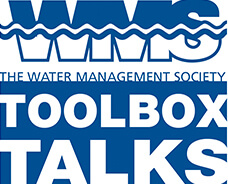As featured in waterline Spring 2020
WMS – TOOLBOX TALKS – SCALE

Scale an introduction – what is scale?
In the water treatment industry scale is a term used to describe a build-up of mineral deposits on the system. The reasons for the formation of the scale can be complex. Scale can contain various chemical compounds sometimes as a mixture. These compounds are commonly formed from the dissolved inorganic impurities found in the water. A common form of scale is the deposit found in kettles in hard water areas.
Some other types of deposits are referred to as fouling which can be caused by microbiological growth or contamination from process (such as oils). If the fouling results in hard deposits it can be referred to as scale. The exact name used to describe the deposit is not important – what is important is to understand what caused the deposit so that action can be taken to remove it and avoid it reappearing.
Calcium carbonate scale (limescale) deposits can be caused by simply warming or evaporation of water containing high hardness and high alkalinity levels. However, there are several factors that can result in deposits, including:
- • mineral impurities (also called dissolved solids) naturally found in water coming out of solution
- • corrosion – most commonly rust deposits from the corrosion of iron
- • incorrect water treatment (e.g. chemicals being incorrectly applied and used, insufficient bleed or blowdown)
- • overheating, low flow or no flow
- • contamination of the system water from any source
The appearance of a scale deposit is not a reliable way to find out what it contains. This requires chemical tests often in a specialist laboratory, although some simple site tests can give an idea of some of the components.
Why is this important?
Scale can cause problems in many types of water systems including domestic water, cooling towers, hot and cold closed water systems, steam boilers, cooling towers etc. Examples include:
- • inefficient heating or cooling, as scale is a poor conductor of heat. This could mean a building is too hot or cold; a ruined product as it was not heated or cooled correctly; damage to equipment due to overheating or even an explosion. It also adds to running costs significantly
- • blockages of pipe work, heat exchangers, lines to instruments and gauges etc.
- • damage to valves and other parts of the system
- • increase in corrosion even with the best treatment chemicals
- • scale can provide protected conditions and surfaces on which microorganisms might grow. Some of these organisms could cause health problems (e.g. legionella) and also cause serious local corrosion
What can be done to control scale?
In order to minimise any scale in a system you need to understand the type of system, how the system operates, the source of water and its quality. The methods to control scale include:
- • reduction in the levels of impurities in the incoming water (by pretreatment plant such as base exchange water softener, RO etc.)
- • addition of acids – great care is needed with this method
- • addition of chemicals known as scale inhibitors – these must be chosen with care
- • limiting the concentration of dissolved solids by removing some system water to drain and topping up with fresh or treated water
- • filtration to remove any deposits before they settle in the system
Usually a combination of methods will be used and expert advice should be sought.
Are there other concerns?
Whatever method of control is selected it is important that its performance is regularly checked. Some methods to control scale can cause other problems such as increased corrosion and some of the chemicals used can be toxic to people or the environment.












